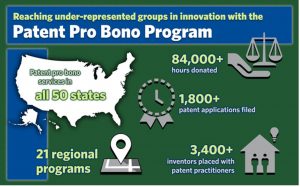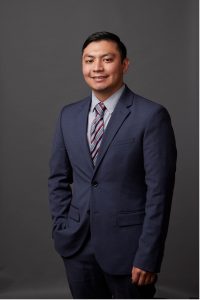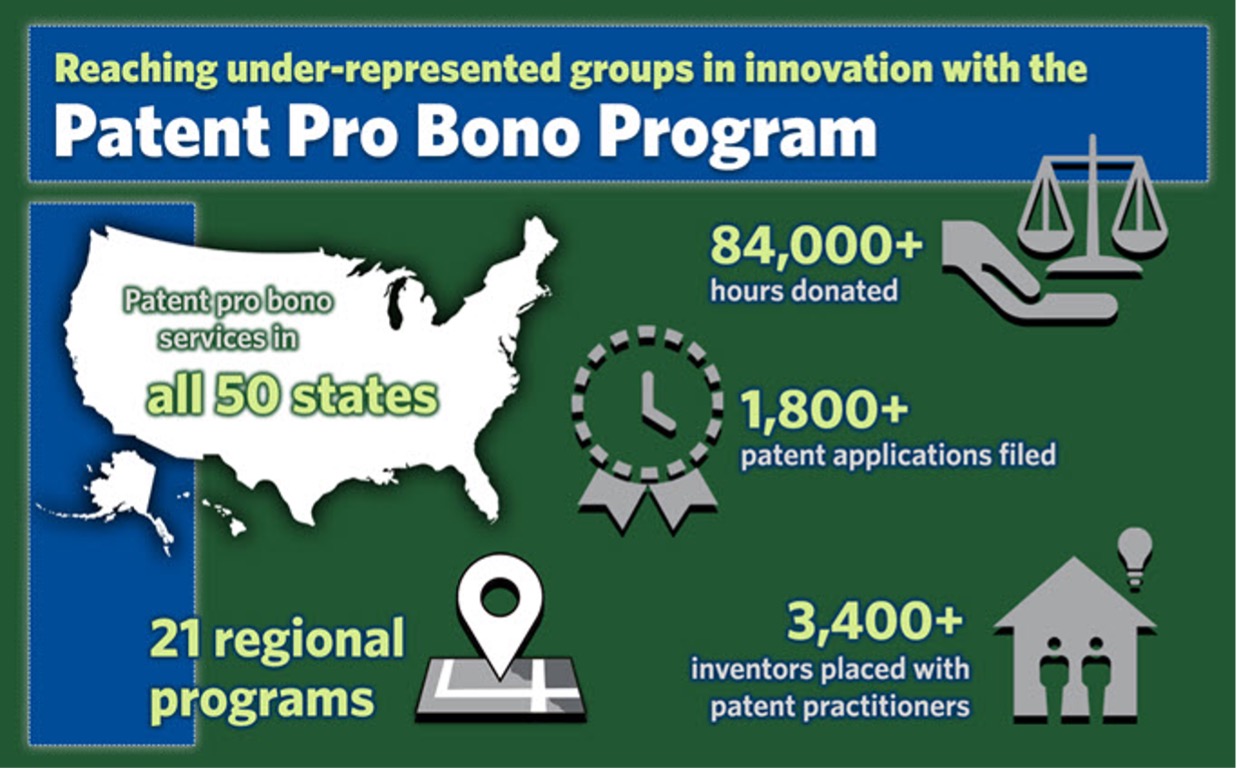Are you a student curious if there is a place for pro bono work in patent law? Are you a practitioner curious about how the U.S. Patent and Trademark Office (USPTO) has addressed accessibility to patent protection? Do you or a friend want to file a patent for an invention but can’t afford a patent attorney? If so, this blog is for you!
I have always been intrigued by accessibility to legal counsel, particularly in areas of law where one would not think that accessibility is an issue. An example of such a field is patent law. This area is largely dominated by corporations that can afford to spend money on expensive patent attorneys. I always wondered, are patent rights only accessible to large corporations that employ hundreds of employees to research and develop new technology? How is innovation stifled by the daunting expenses that face someone seeking a patent? Big companies can afford to spend large portions of their budgets on research and development. As a result, they file dozens of patents annually. However, a large number of smaller companies and individuals also develop new inventions. Both big and small companies that desire to patent their inventions must go through the USPTO’s patent application process.
While working at an IP boutique firm (i.e. a firm that focuses solely on IP) during my 1L summer, I learned the true cost of this patent application process, also known as “patent prosecution.” This worried me, as it appeared that smaller companies would be systematically harmed by the payment requirements. Fortunately, as the summer went on, I learned that the USPTO operates a nationwide program that assists small companies and individual inventors with the patent prosecution process.
The USPTO’s Patent Pro Bono Program
In 2011, the USPTO launched the Patent Pro Bono Program. The Patent Pro Bono Program allows inventors who meet certain qualifications to receive free legal assistance in preparing  and filing a patent application. This program is currently accessible to inventors in all 50 states. It is composed of a nationwide network of independently operated programs that serve defined regions of one or more states. Inventors who meet the guidelines of their regional program are matched with a volunteer patent professional who aids them in the process of securing patent protection.
and filing a patent application. This program is currently accessible to inventors in all 50 states. It is composed of a nationwide network of independently operated programs that serve defined regions of one or more states. Inventors who meet the guidelines of their regional program are matched with a volunteer patent professional who aids them in the process of securing patent protection.
Who Qualifies for the Patent Pro Bono Program?
The USPTO has three general requirements for admission into the Patent Pro Bono Program. The three requirements focus on the inventor’s income, the inventor’s knowledge of the U.S. Patent System, and the inventor’s ability to adequately describe the invention. The Patent Pro Bono program is subdivided into regional programs, such as Illinois’s Chicago-Kent Patent Hub. The regional programs may cover more than one state, and on certain occasions a regional program may provide exceptions to the USPTO’s requirements. Therefore, it is important for potential applicants to find their region on the USPTO’s interactive Patent Pro Bono Coverage Map.
Income
In general, applicants to the Patent Pro Bono Program must prove that each listed inventor has a household income of less than 3 times the federal poverty level guidelines. The same rule applies to small businesses, but regional programs may require that the small business meet additional total gross income requirements. Your regional program may expand or narrow income requirements.
For example, if you are an applicant from Illinois then your regional program is the Chicago-Kent Patent Hub. The Chicago-Kent Patent Hub requires that the income limit for inventors is 3 times the federal poverty level, with an exception of 5 times the federal poverty level for inventors that are U.S. military veterans. Further, under the Chicago-Kent Patent Hub’s guidelines, applicants that are small businesses must have had a total gross income of less than $150,000 in the preceding calendar year and expect a total gross income of less than $150,000 in the current calendar year.
Knowledge
The USPTO also requires applicants to the Patent Pro Bono Program to demonstrate sufficient knowledge of the U.S. patent system. This knowledge can be demonstrated in one of two ways:
- Having a provisional patent application on file with the USPTO, or
- Successfully completing the USPTO’s Basic Patent Training Certification Course.
A provisional patent application is a simplified application filed with the USPTO that grants limited protections for a period of 12-months. The USPTO’s Basic Patent Training Certification Course is a series of six computer-based training modules designed to teach independent inventors about different aspects of patent applications, patent prosecution at the USPTO, and what happens when you receive a patent. This course can be completed online for free without the need of any legal counsel.
Invention
Lastly, in order to qualify for the Patent Pro Bono Program, you must be able to describe the particular features of your invention and how it works. This requirement extends beyond a basic description by requiring the inventor to provide sufficient details to accurately describe how someone else could replicate the invention.
The Catch?
Qualifying for the Patent Pro Bono Program allows inventors to receive pro bono services from a licensed patent agent or attorney. Unfortunately, that is all an inventor can get for free. Applicants are still responsible for the USPTO fees, which include filing, searching, examination, and issuance fees. The search fee covers a search of other patents and sources that may render your invention as not novel, or new. In addition, if you are granted a patent, you are responsible for patent maintenance fees every few years. A full list of the USPTO’s fees and fee schedule is available here.
Although the list of fees is extensive and might seem daunting to some, there are some good news regarding the USPTO fees. Specifically, those who qualify for the Patent Pro Bono Program may also qualify for reduced USPTO fees if they qualify for the status of “small entity” (50% discount of fees) or “micro entity” (75% discount of fees). A small entity is generally defined as a business with fewer than 500 employees total, or an individual that has not conveyed or promised to convey any interest in the invention to an entity that is not a small entity. A micro entity meets the requirements of a small entity, as well as additional gross income requirements. The USPTO lays out the requirements to qualify for each status here.
By allowing small and micro entities to pay lower fees and offering the Patent Pro Bono Program, the USPTO has taken significant steps to increase accessibility to patent protection for smaller companies. Making the patent system more accessible for smaller companies is consistent with the goal of promoting innovation because being able to access patent rights, even if you are not a big company, incentivizes inventors to pursue new technologies.
Attorneys interested in participating in the Patent Pro Bono program can apply to volunteer directly with the Patent Pro Bono Program in their geographic region. Although the patent Pro Bono Program does not have direct opportunities for law students to volunteer, students working at law firms that have an IP practice can ask the IP attorneys at their firm if they can volunteer in the patent Pro Bono program by assisting them. Although I have not gotten involved with the Patent Pro Bono program myself, it is definitely something that I look forward to getting involved with after law school.

Manuel (Manny) Franco
Associate Blogger
Loyola University Chicago School of Law, J.D. 2024
